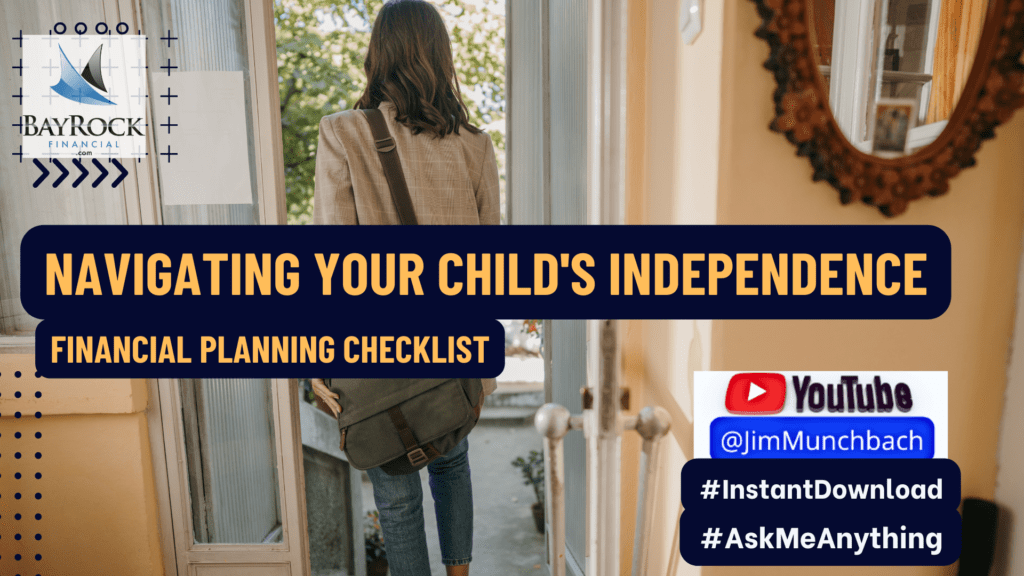Navigating Your Child’s Independence Checklist
Many parents wonder how their own finances will change as their children become independent. Where should parents set boundaries with their children? How much involvement and support should they maintain? What important planning considerations should parents be aware of, and how can they make informed decisions that benefit both themselves and their children? That’s where you come in.
Navigating Your Child’s Independence – Pop’s Perspective
My kids are all grown up. But today is a very special day because my favorite Grandson is turning 5… As I’m writing this post, I’m thinking about all the ways I want to help, teach, and mentor. My wife, Connie, was born to be a kindergarten teacher. Every year she watches a new group of her (now old) kindergarten students graduate from college. So, for anyone who’s looking for a little Independent Fiduciary Advice about Navigating Your Child’s Independence, Click Here to download the Checklist. #InstantDownload
With this checklist, you can gain a better understanding of the steps you can take now and in the future to ensure personal and financial success as your children become independent.
This checklist is designed to assist parents in navigating the key issues they must consider during their child’s journey to independence, including:
Maintaining Access to Important Information: Ensure continued access to your child’s crucial health, financial, and academic records.
Evolving Financial Goals: Understand how your financial goals may change or require reassessment once your child leaves the family home and becomes independent.
Financial Boundaries: Determine the level of financial intertwining between you and your child as they gain independence. Consider areas such as taxes, health insurance, auto insurance, gifting, and more.
Assessing Risk and Liability: Evaluate the potential risks and liabilities your child may present to your own finances. Take proactive steps to protect yourself and make informed decisions.
By addressing these considerations and utilizing the checklist, parents can navigate the transition to your child’s independence with confidence and ensure a secure financial future for both yourselves and your children.
Navigating Your Child’s Independence is Challenging
As parents, watching our children grow and become independent individuals is both rewarding and challenging. As your child reaches adulthood, there are several crucial aspects to address to ensure a smooth transition and protect their well-being. This guide will walk you through essential considerations and actions to take as your child becomes independent.
Guide to Navigating Your Child’s Independence: Key Considerations and Actions
1. Safeguarding Important Records and Privacy
In case of emergencies, it’s important to maintain access to your child’s vital records such as health, academic, and financial information even after they turn 18. To do so, encourage your child to sign a Health Insurance Portability and Accountability Act (HIPAA) and Family Educational Rights and Privacy Act (FERPA) waiver form. These waivers will grant you access to their protected information when needed. Also, consider discussing and potentially executing durable medical and financial power of attorney documents to ensure you can act on their behalf if necessary.
2. College and State Residence Requirements
If your child is attending college or moving out of state, it’s crucial to review any in-state versus out-of-state residence requirements. Ensure both you and your child have the necessary documentation, such as driver’s licenses, insurance policies, and important forms, for both your state of residence and their state of residence. This preparation will help avoid any potential administrative or legal challenges.
3. Health Insurance Coverage
Evaluate whether it’s appropriate for your child to remain on your health insurance plan if they are still eligible (i.e., under 26 years old). Consider the cost and coverage aspects of keeping them on your plan. Additionally, determine if your health insurance is Health Savings Account (HSA)-eligible. If your child can no longer be claimed as a dependent, they may open and fund their own HSA up to the family contribution limit, separate from your limit.
4. Financial Adjustments
Review your budget and expenses once your children leave the house. Determine how your financial situation may change depending on the level of continued support you wish to provide them. Assess any potential increase or decrease in expenses and make necessary adjustments to ensure financial stability.
5. Housing Considerations
If you are considering moving or downsizing your home after your children leave the house, carefully evaluate the potential benefits. Moving or downsizing can lead to advantages such as mortgage elimination or reduction, decreased living expenses, and better location choices. Analyze your specific situation to determine if such a change would be beneficial.
6. Revisiting Financial Goals
With your children becoming independent, it’s essential to revisit your financial goals. Consider how your goals may have changed, such as retirement plans, travel aspirations, or supporting family members. Assess whether you are still on track and if any adjustments to your financial plan are necessary to align with your new circumstances.
7. Supporting Large Expenses and Monetary Assistance
If you plan to help your children with significant upcoming expenses like weddings, vehicles, or down payments on a house, evaluate the impact on your own finances and goals. Keep in mind that gifts exceeding the annual gift tax exclusion ($17,000) must be reported. If your children request additional monetary support even after achieving independence, consider providing family loans instead of gifts. Ensure the interest rate aligns with the appropriate Applicable Federal Rates (AFR) to avoid any taxable imputed interest penalties.
8. Business Ownership and Employment
If you own a business, contemplate whether hiring your children could be advantageous. By employing them, you may save on taxes by “shifting income” to their lower tax bracket. The first $13,850 your child earns is federally tax-free and potentially payroll tax-free if they are under 18 years old. Additionally, earned income can enable your child to start their Roth IRA savings early.
9. Tax Implications
Reevaluate whether you should claim your child as a dependent on your tax return. Consider the phaseout ranges and non-refundable nature of education tax credits (such as the American Opportunity Tax Credit and Lifetime Learning Credit) based on your income level. Adjust your strategy accordingly to optimize tax benefits. Also, assess how your taxes might change once your child becomes independent, accounting for any loss of credits or deductions.
10. Risk Management and Insurance
Ensure your child’s safety and protection by addressing several risk management factors. If your child is moving to or already attending college away from home, consider purchasing renters or dorm insurance to provide appropriate coverage. If concerns arise regarding your child’s fiscal responsibility, consider paying for expenses directly instead of giving cash. Monitor their access to certain accounts and establish restrictions if necessary.
11. Planning for Health Issues and Disabilities
If your child has serious health issues or disabilities, take proactive steps to protect their well-being. Establish a support system before they leave for college and ensure all necessary paperwork is in place. This will help ensure they receive the required assistance and care while away from home.
12. Driving and Liability Protection
If your child is driving and still considered your dependent, evaluate whether obtaining a separate auto insurance policy for them would be appropriate. This additional layer of liability protection can help safeguard your financial interests. Be mindful of any limitations and potential gaps in coverage.
13. Life Insurance and Estate Planning
Review your life insurance policies and assess whether any adjustments would benefit your situation. Consider factors such as a decrease in death benefit or exploring options like a 1035 exchange or policy surrender. Additionally, if your children are old enough and qualified, update your estate documents to include them in decision-making roles such as power of attorney, executor, or trustee.
14. Specific State Planning Considerations
Research and address any state-specific planning issues that may be relevant to your situation. Familiarize yourself with local regulations and requirements to ensure comprehensive planning and compliance.
Conclusion
As your child embarks on their journey to independence, it’s essential to be proactive and address the various considerations outlined in this guide. By taking appropriate actions and planning ahead, you can ensure a smooth transition, protect your child’s interests, and align your financial and risk management strategies accordingly. Stay informed, adapt to changes, and enjoy this new phase of your child’s life.
Download our comprehensive checklist: Guide to Navigating Your Child’s Independence. The checklist will assist you in navigating this transition smoothly.
Click here to instantly download the Guide to Navigating Your Child’s Independence checklist. #InstantDownload
Remember, planning for your child’s independence is crucial for their future well-being and your peace of mind.






